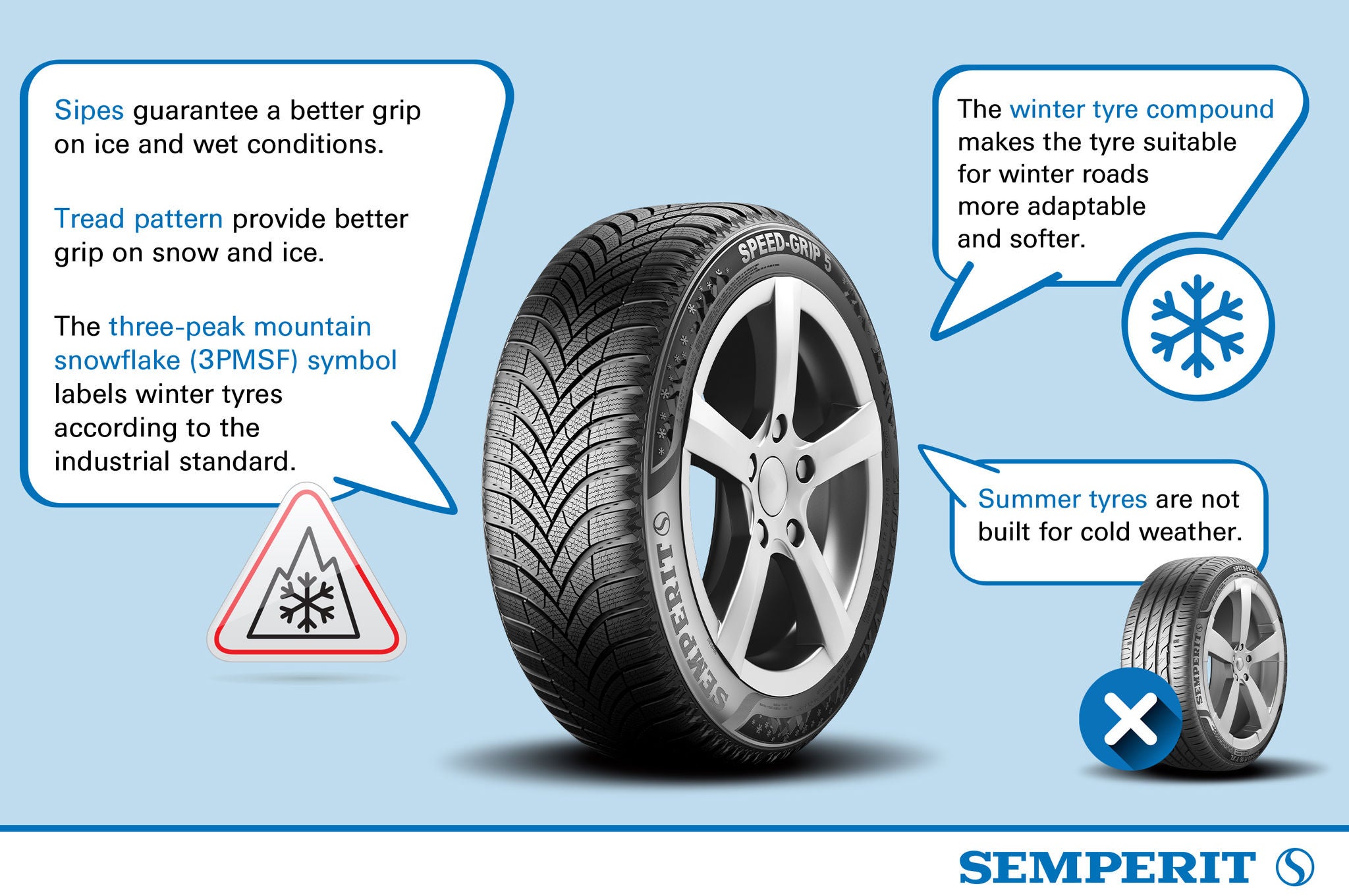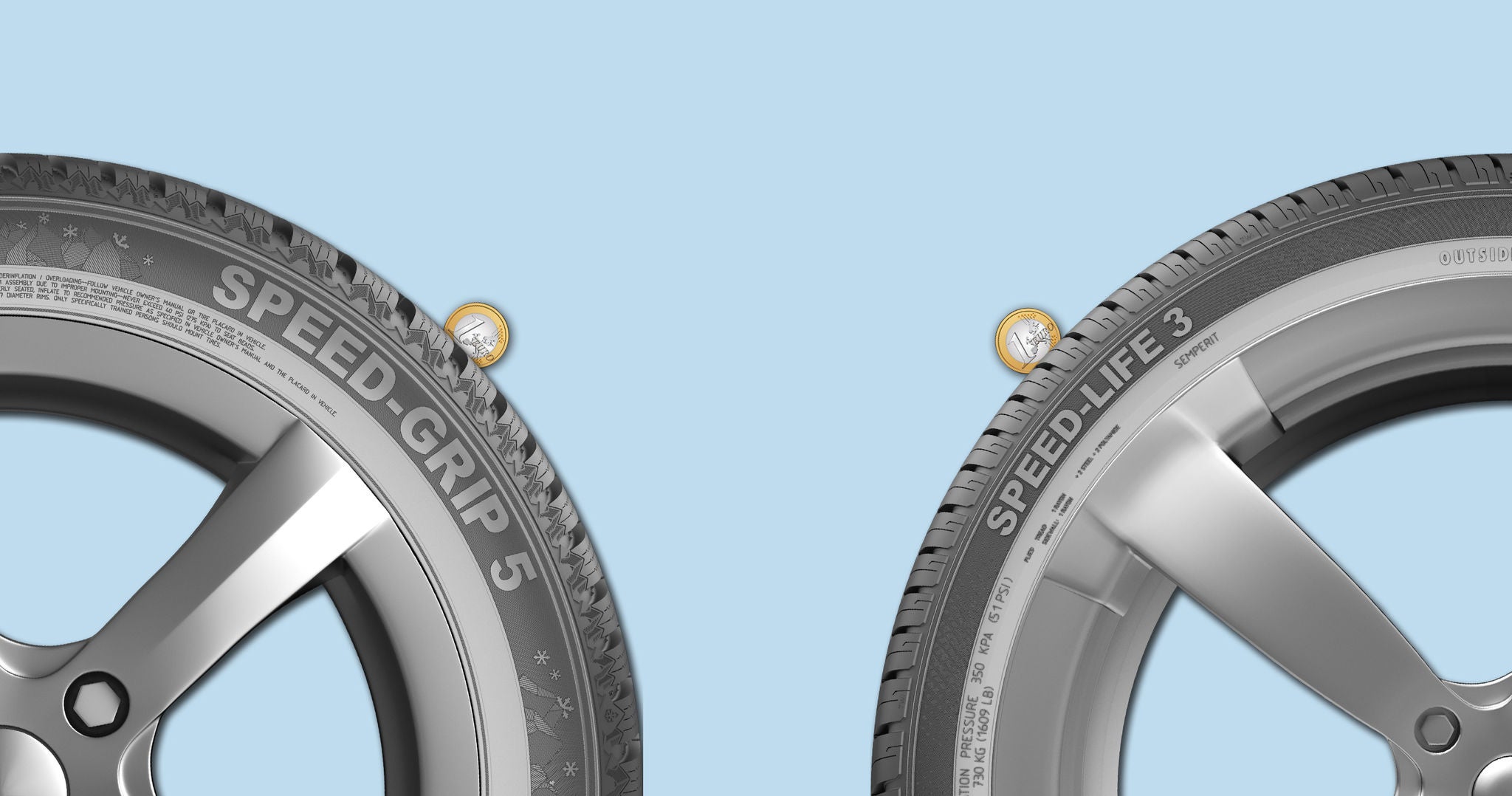
As the temperature drops, roads get frostier, and mist is spreading over streams and lakes. Autumn is making its presence known. Time to find out about the perfect winter tyre to get through the icy season with solid alpine driving performance. Here are some tips on what makes a good winter tyre, what to look for when buying winter tyres and what air pressure your tyre needs to have.
What makes a good winter tyre?
Winter tyres have a dedicated tread pattern, tyre compound and tyre structure, which are primarily designed to perform better than on snowy roads. The winter tyres’ compound has a higher proportion of natural rubber, which provides better road stability and grip at low temperatures. This compound makes the tyre more adaptable and softer on winter roads than summer tyres.

In addition, the tread pattern also plays a significant role on the performance of a tyre on snow-covered and slushy roads:
- Tread blocks are raised and can dig deeper into snow and slush and provides better grip on winter roads.
- Grooves are wider and deeper than on summer tyres and drain the snow and slush better. This provides extra grip, and the risk of aquaplaning is minimised.
- Sipes claw into the snow and enable progress in deep and alpine snow conditions.
- Ribs interlock on the wintry road and allow for better steering on snowy, wet and icy roads.
What do the markings on winter tyres mean?
You can identify winter tyres by the symbols on the sidewall.
These are the M+S symbol and the three-peak mountain snowflake (3PMSF) or Alpine symbol, and both are industry standards. The 3PMSF (Alpine) symbol is mandatory for winter or all-weather tyres produced since 1st January 2018.
- The 3PMSF (Alpine) symbol identifies winter tyres according to a defined industry standard (UNECE regulations). They perform exceptionally well in terms of safety and control on snow, icy roads and generally at low temperatures. In winter road conditions, we recommend putting on winter tyres with the three-peak mountain snowflake symbol.
- The M+S symbol stands for "Mud and Snow". Manufacturers use it to identify tyre models that are suitable for winter driving conditions. The symbol is not protected and is not subject to any parameters that tyres must fulfil in order to receive this designation. Therefore, there is no guarantee that tyres with this symbol provide the necessary grip and safety in winter driving conditions.
Please always observe the local legislation, when buying new winter tyres. For example in Germany only the three-peak mountain snowflake symbol is valid, while in Austria the M+S marking is still sufficient.
- Semperit Team
What is the minimum tread depth required by law for winter tyres?
Not only is the marking of winter tyres crucial for getting through the winter with the necessary grip, but the minimum tread depth also plays a significant role.

Especially on wet or slippery roads, cars with worn treads quickly lose grip. Legally the minimum tread depth is 1.6 millimetres. These tyres are then no longer considered roadworthy and must be disposed of at a specialist facility. In some European countries, such as Austria, winter tyres with a tread depth of less than 4 mm are even considered summer tyres and may not be driven in winter road conditions. Please note that safe driving in wet and snow conditions is influenced not only by the tread depth but also by the tread design and rubber compound. On rain-slick or snow-covered roads, braking performance of your vehicle is reduced as tread depth of your tyres decreases. On wet roads, there is also an increased risk of aquaplaning as tread depth decreases.
It is also very easy to measure the tread depth by placing a 1 euro coin into the groove of the tyre. If the golden rim appears above the tread, it is time to replace the tyre. Test both in the centre of the tyre and at the edge of the tyre. Please take this measurement on each of the four tyres. It is possible that the tyres wear differently due to effects of driven and non-driven axle, but also by incorrect tyre pressure or loading. We recommend that you always change all four tyres at the same time so as not to endanger driving safety and to minimise the risk of skidding. For your safety, Semperit winter tyres also have 4 mm winter indicators.
What pressure should I keep my winter tyres at?
Maintaining the correct tyre pressure is crucial as it can affect tyre performance in many ways, considering safety and environmental aspects. If the tyres of your car are only 0.5 bar underinflated, the braking distance is already extended. At high speed and temperature, the tyre may even burst. Fuel consumption also rises with low air pressure, as the rolling resistance increases. In wintertime at low temperature the question of tyre pressure plays an important role, because cold air is denser than warm air and leads to a smaller volume in the tyre. This means that the colder it gets, the lower the air pressure in the tyre.

Therefore, we recommend that you check the tyre pressure every fortnight at the filling station. You can find out which tyre pressure is optimal for your winter tyres here:
- In the vehicle handbook in the car
- Inside the fuel filler cap
- On the driver’s door post
- Directly from the manufacturer, vehicle dealer or qualified tyre professional
Tip from Semperit: Increase the specified tyre pressure by a small 0.2 bar. This way you can save fuel without losing driving comfort.
Should I switch to wider winter tyres?
Reasons why manufacturers are switching to wider tyres can range from performance enhancements to aesthetic appearance. Those tyres:
- have more sipes
- have larger tread blocks that interlock effectively with the road surface
- ensure better steering precision and handling in snow and ice
Again, you can find out which tyre dimension is the right one for your winter tyre on the tyre sidewall, the driver's side door frame, the owner’s handbook or under the fuel cap.

Things to know about the age of your tyres
Therefore, we recommend that you check the tyre pressure every fortnight at the filling station. You can find out which tyre pressure is optimal for your winter tyres here:
- In the vehicle handbook in the car
- Inside the fuel filler cap
- On the driver’s door post
- Directly from the manufacturer, vehicle dealer or qualified tyre professional
Tip from Semperit: Increase the specified tyre pressure by a small 0.2 bar. This way you can save fuel without losing driving comfort.
When should I replace my winter tyres?
There are no legal regulations regarding the age of a car tyre, but the age of the tyres is a decisive safety factor. This is why tyres should be replaced after ten years at the latest – regardless of whether they are summer or winter tyres. The production date (normally linked to the DOT marking) on the sidewall provides information about the tyre age. Much more important than the age of the tyre is the wear. Pay attention to the minimum tread depth and signs of wear such as cracks or damage.
If you observe these parameters of a good winter tyre, nothing stands in your way of safe alpine driving performance during the winter months. Semperit recommends the winter tyres Speed-Grip 5 for solid driving stability on snow and ice or Van-Grip 3 for vans and transporters in winter use. Feel free to contact a Semperit tyre specialist for advice on buying winter tyres.
Related topics
-
 2023/03/31EU tyre labelBased on the three criteria safety, fuel efficiency and noise, the EU Tyre Label provides information on the environmental and safety characteristics of a tyre.Read more
2023/03/31EU tyre labelBased on the three criteria safety, fuel efficiency and noise, the EU Tyre Label provides information on the environmental and safety characteristics of a tyre.Read more -
 2023/03/31Maximum gripOn the road or on the slopes - you can't do it without great grip on snow and ice! ► The fun of skiing and snowboarding.Read more
2023/03/31Maximum gripOn the road or on the slopes - you can't do it without great grip on snow and ice! ► The fun of skiing and snowboarding.Read more -
 2024/09/30Winter tyre lawsWhen are winter tyres compulsory? ► Here you will find all the important information on the obligation to have winter tyres in Europe!Read more
2024/09/30Winter tyre lawsWhen are winter tyres compulsory? ► Here you will find all the important information on the obligation to have winter tyres in Europe!Read more